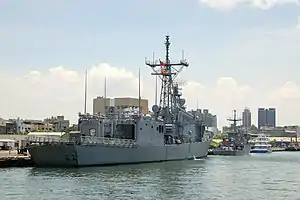 ROCS Cheng Kung on 12 June 2015 | |
| History | |
|---|---|
| Name |
|
| Namesake | Cheng Ch'eng-kung |
| Ordered | 8 May 1989 |
| Builder | |
| Laid down | 21 December 1990 |
| Launched | 5 October 1991 |
| Commissioned | 7 May 1993 |
| Identification | Pennant number: PFG2-1101 |
| Status | in active service |
| General characteristics | |
| Class and type | Cheng Kung-class frigate |
| Displacement | 4,103 long tons (4,169 t) full |
| Length | 453 ft (138 m) |
| Beam | 46.95 ft (14.31 m) |
| Propulsion | General Electric LM2500-30 gas turbines, 40,000 shp total |
| Speed | 29 knots |
| Complement |
|
| Sensors and processing systems |
|
| Electronic warfare & decoys |
|
| Armament |
|
| Aircraft carried | Sikorsky S-70C-1/2 |
| Aviation facilities | Hangar and helipad |
ROCS Cheng Kung (成功, PFG2-1101) is the lead ship of eight Cheng Kung-class guided-missile frigates, which are based on the Oliver Hazard Perry class of the United States Navy.
Construction and career
Laid down on 2 December 1990 and launched on 27 October 1991, Cheng Kung was commissioned in service on 7 May 1993. All of these Taiwanese guided missile frigates have the length of the later long hull Oliver Hazard Perry-class vessels, but have a different weapon and electronics fit.[1]
In order to control the different weapon systems on board that the Mk 92 cannot integrate into, a second CDS, H930 MCS was installed on all eight ships in order to control the eight HF-2 (or four HF-2 and four HF-3 on PFG-1101 and PFG-1105) and the two Bofors 40 mm/L70 guns (except on PFG-1110). The rest of the ships in this class will receive four HF-3 upon their major overhaul.[1]
Gallery
 ROCS Cheng Kung and ROCS Chi Kuang
ROCS Cheng Kung and ROCS Chi Kuang A model of ROCS Cheng Kung
A model of ROCS Cheng Kung
References
- 1 2 Lundquist, Edward H. "Interview with Adm. Richard Chen, Republic of China Navy (Ret.)". www.defensemedianetwork.com. Defense Media Network. Retrieved 8 August 2019.